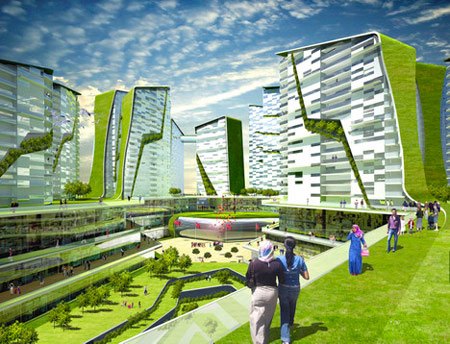The hot topic in urban agriculture today is vertical farming, which has become the de facto solution for growing produce in crowded city environments. Vertical farming is exactly what it sounds like: You construct a building with glass walls and multiple levels. Think of a bunch of greenhouses stacked upon one another. Technology and crop rotation allows the vertical farmer to retain nutrients within the structure, creating a sustainable, ecologically friendly environment.
Dickson Despommier is the leading voice behind vertical farming. He’s been thinking about it for years, and recently wrote a book on the topic. Despommier believes that the technology is finally available to make vertical farming a reality.
Sounds great, right? Unfortunately, there are a few problems.
- Prohibitively expensive to construct, possibly $100 million USD for a 60 hectare vertical farm.
- In non-ideal environments, such as a desert region, these structures will require external energy sources.
- All buildings will require their own heating and cooling systems, which will use lots of energy.
- Owners of vertical farms are unlikely to be altruistic; they will exist to reap profits.
- Vertical farms will require an internal source of carbon dioxide to boost plant yields; this literally means burning fossil fuels within the structure.
Despommier believes that the question isn’t whether vertical farms will be built, but who will build the first few. Given the cash-strapped reality of America’s large cities, we are unlikely to see one in the United States anytime soon. China, Japan, and the Middle East are much more likely candidates to be the first entrants into vertical farming. With enough time, techniques will improve and costs will surely be driven down to the point that it could be a viable solution around the planet.
An alternative to the farmscraper is Ken Yeang’s vision for mixed-use buildings that flow seamlessly with green space, also known as vegetated architecture. Rather than construct a building dedicated to farming, Yeang would distribute farming needs to their demand, like a community garden.

See the difference? It’s hard not to think of Yeang’s approach as the more elegant, practical, sustainable solution for most cities. Those in harsher climates will have less success with vegetated architecture.
If vertical farming and vegetated architecture are two visions for the future of urban agriculture, what’s the focus today? James McCrae, a green thumb quoted in an article on Grist, says that we need to stay close to the ground.
“You don’t have to reinvent the wheel to grow food in the city, and spend a whole lot of money — you just got to find the open space, ask for it, and do the work,” he said. “People think, ‘No one’s gonna let me do that, no one want to hear from me,’ but they don’t ask! People get depressed, they get lazy.”
McCrae’s advice is spot-on. We don’t need to open up wallets to get urban agriculture going, we just need to roll up our sleeves.